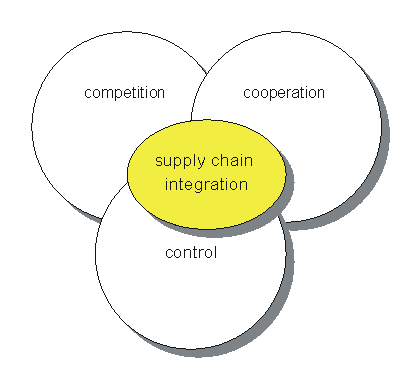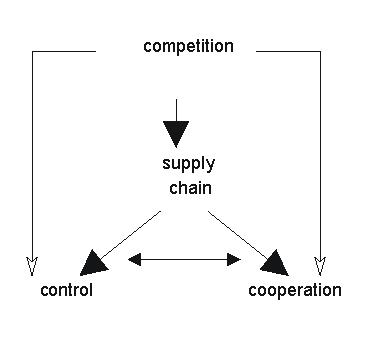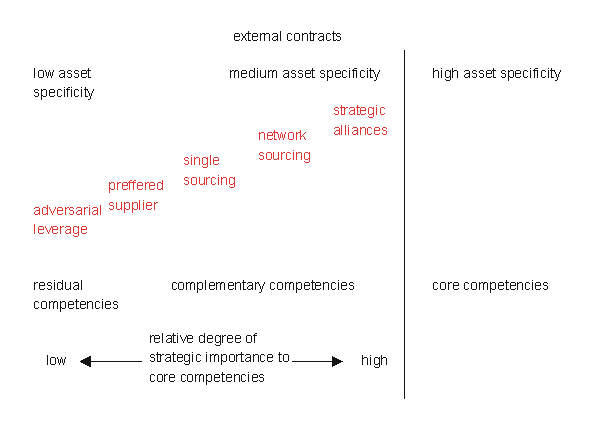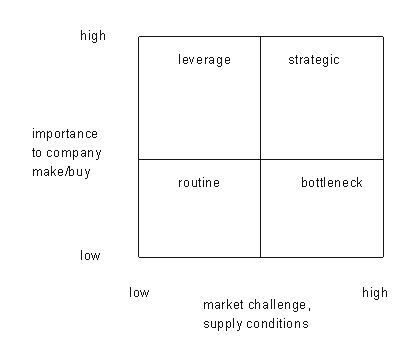|
|
|
FORMS OF MARKET COORDINATION VERSUS SUPPLY CHAIN MANAGEMENT AS COMPANIES CORE COMPETENCIES Anna Łupicka ABSTRACT Basic issues of logistics and SCM must be analyzed against the network among companies. Definitely most important are relationships, in which some companies are suppliers and others receivers. In the context of supplier-receiver relationship the problem of coordination and its impact on companies activities is involved. The supply chain is a specific example of companies' ties, where different ways of coordination interchange starting from competition throw control finishing on cooperation. It is worth emphasizing that the concept of integration, which may create a huge competitive advantage stemming from improving responsibility and cost reduction, leading to modern activities and greater profitability of companies in the supply chain does not have to refer only and exclusively to cooperation. Basic issues of logistics and supply chain management must be analyzed against the network among companies. Definitely most important are relationships in which some companies are suppliers and others buyers. In the context of buyer-supplier relationships the problem of coordination and its impact on companies activities is involved. The supply chain is a specific example of companies' ties, where different ways of coordination interchange starting from competition throw control finishing on cooperation. It is worth emphasizing that the concept of integration, which may create a huge competitive advantage stemming from improving responsibility and cost reduction, leading to modern activities and greater profitability of companies in the supply chain does not have to refer only and exclusively to cooperation relations. All the possible situations in the relation buyer-supplier in the supply chain are described by "KKK" paradigm. Apart from competition and cooperation it also indicates control understood as striving to reach economic power or as striving to obtain and use more bargaining power. The "KKK" mechanisms are equally strong ways of interorganizational coordination of decisions. Strengthening the company's position on the market is connected with competing if an organization considers that this method will help in reaching the valorization goals of the possessed resources or when it is unable to apply control strategy and/or cooperation strategy. Strategic analysis reveals their advantages and disadvantages in the defined market configuration and companies' resources [Sulejewicz 1997]. Thus the supply chain integration is a mixture of competition, cooperation and control. Considering "KKK" paradigm against the supply chain integration it is worth noticing, that the form of coordination tied with competition may also appear as the first level of creating supply chain integration. Then the remaining forms of coordination can be recognized as further levels of supply chain integration.
In the literature of the subject research results concerning the first relations are most frequently present. It is likely that an attempt of examining the relations producer-distributor or producer-logistics operator. The third type of relations may result from a growing role of logistics operators in the coordination of supply chain functioning. Deciding on examining the above relations it is necessary to answer a few basic questions:
Undoubtedly, achieving competitive advantage is possible on the way of using and improving core competencies. Prahalad and Hamel define a core competence as follows: A core competence is a bundle of skills and technologies that enables a company to provide a particular benefit to customer. One of the core competencies as mentioned earlier is supply chain management. Core competencies are skills or capabilities that make an organization unique. The economic power of the firm in supply chain depends on skills and technologies which they posses. Understanding the nature of power in the relationships is very important. Researches in the automotive industry improve that attempts to verify partnering benefits generally finds that the rewards tend not to be realized until several years after alliances formation, hinting at the necessary long-term nature of the relationship [Maloni, Benton 2000]. Though no quantifiable boundary exists between a transactional and integrated relationship, several key elements make the integrated relationship unique including trust, cooperation and commitment.
Power may be defined as the ability of one firm (the source) to influence the intention and action of another firm (the target). A lot of scientists tried to explore inter firm power research in the development of the bases of power. Table 2 shows these bases, which examine the perceived reasons why one party may hold authority over another. Reward and coercive remain the most transparent and recognized power bases, indicating the ability of the source to mediate dividends or punishment to the target. Other power bases may also retain a prominent role in the supply chain. For one, expert power refers to the perception that one firm holds information or expertise that is valued by another firm. Another consequential base, referent power, implies that one firm desires identification with another for recognition by association. Finally, legitimate power, which includes both its inherent and legal forms, infers that target believes in the right of the source to wield influence [Maloni, Benton 2000]. Logistics researchers have applied the power literature to the analysis of marketing channel relationships and have found that the different bases of power affect inter-firm relationships in significant, yet contrasting ways. The significant and expansive effects of power on inter-firm relationships hold direct implications for the supply chain. Power affects the elements (trust, cooperation, commitment, conflict and conflict resolution) critical to effective supply chain integration, so power may play a consequential role in the formation and maintenance of supply chain relationships. There is one conclusion which improve that firms which have more power in supply chain, consequently have more skills and better technologies as theirs core competencies. There are a lot of examples of commitment between core competencies and supply chain integration.
A model proposed by Cox placing the supplier relationship in relation to core competence. The model proposes five supplier relationship structures:
Cox uses the term "assets specificity" to describe how close to a company's core competencies a supplier's product may lay. However, whilst the model was accepted on a theoretical basis, it was not viewed as a useful tool. Whilst it was recognize that the model proposed by Cox reflected the nature of customer supplier relationships, in practice a simpler four-box model proposed by Kraljic was found to be actively used to manage the relationship. It was though to better describe the process and to drive the business to achieve the desired nature of relationships. There are four boxes:
SUMMARY There are issues around core competence protection, which need consideration in all supplier relationships. Relationships are dependent on the relative market power relationship between buyer and supplier. In many economic sectors those companies that have direct contact with final customers often hold the balance of power. Knowledge of the organization's position within the industry is required in order to identify particular strengths and weaknesses. Core competencies are specific strengths, which mean for the company a set of skills, and technologies that enable a firm to provide a particular benefit to customer. REFERENCES Hines T., 2004, Supply Chain Strategies, customer-driven and customer-focused, Elsevier Butterworth-Heinemann, Oxford. Logistics Research Network, 2005, Conference Proceedings United Kingdom. Maloni M., 2001. Power in supply chain, Journal of Business Logistics, vol. 21, No. 1. Sulejewicz A., 1997, Partnerstwo strategiczne: modelowanie współpracy przedsiębiorstw, SGH Warszawa. FORMY KOORDYNACJI RYNKOWEJ A ZARZĄDZANIE ŁAŃCUCHEM DOSTAW JAKO KLUCZOWEJ KOMPETENCJI FIRM
STRESZCZENIE Podstawowe zagadnienia logistyki i zarządzania łańcuchami dostaw muszą być analizowane na tle siatki powiązań miedzy przedsiębiorstwami. Najważniejszymi relacjami w łańcuchu dostaw są relacje zachodzące pomiędzy dostawcą i odbiorcą. Łańcuch dostaw jest swoistym przykładem powiązań firm, w którym przeplatają się różne sposoby koordynacji począwszy od konkurencji przez kontrolę a skończywszy na kooperacji. Warto zauważyć, że pojęcie integracji, która koncepcyjnie może tworzyć ogromną przewagę konkurencyjną wywodzącą się z poprawiania odpowiedzialności i redukcji kosztów, prowadzącą do nowoczesnych działań i większej opłacalności firm w łańcuchu dostaw nie musi oznaczać stosunków kooperacyjnych. dr Anna Łupicka |
Copyright © 2005 LogForum, Wyższa Szkoła Logistyki, ul.E.Estkowskiego 6, tel. 061 852 95 55, 851 06 04, tel./fax. 061 851 06 03 |




